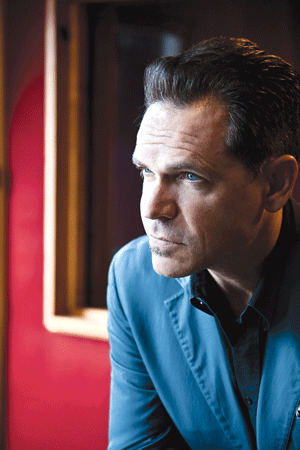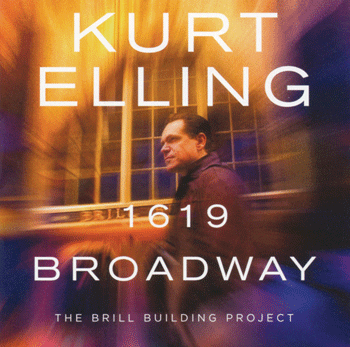By MORDECAI SPECKTOR
In the 1960s, American pop music had an address: the Brill Building, 1619 Broadway, New York City. The office building, which started housing music publishers in the 1930s, became a nexus of the music business, with record labels, publishers, management firms, demo studios and songwriters populating the warren of offices.
The latter category included such music luminaries as Jerry Leiber and Mike Stoller, Howie Greenfield and Neal Sedaka, Barry Mann and Cynthia Weil, Gerry Goffin and Carole King, Doc Pomus (né Jerome Felder) and Mort Shuman, Paul Simon, et al.
As the preceding list indicates, Jews were disproportionately represented among the ranks of the tunesmiths. In fact, without the contributions of Jews, the Great American Songbook, along with the later rock ’n’ roll canon, would be seriously depleted.
In a loving homage to these songwriters, acclaimed jazz vocalist Kurt Elling has created a new album, 1619 Broadway: The Brill Building Project (Concord Jazz). Jewish songwriters had a hand in writing nine of the 11 songs on the album.
Music fans in the Twin Cities will have a chance to hear live renditions by the Grammy Award-winning singer, when Elling performs two shows Oct. 23 at the Dakota Jazz Club in Minneapolis. He will be backed by a quartet of ace musicians: Laurence Hobgood, piano; John McLean, guitar; Clark Sommers, bass; and Kendrick Scott, drums.

Elling, a Chicago native — who attended Gustavus Adolphus College , in St. Peter, Minn. — talked to the AJW last week from his home in New York City, where he’s lived for the past several years.
“As a jazz person, it’s most natural for me to gravitate toward the so-called Great American Songbook — not primarily, but largely,” Elling commented, when asked about the origins of his new album. “It is also natural for me to gravitate toward compositions that have come from jazz people, since the Songbook. I’ve written a lot of lyrics for the music of Wayne Shorter, Herbie Hancock… Joe Zawinul, people of that ilk and of that level of mastery.”
The 45-year-old singer explained, regarding the Brill Building songs, that he has “done a lot of things revolving around Chicago, fanatically,” including recorded pieces, spoken word and theatrical projects. Since his move to the Big Apple, he “wanted to respond to New York a little bit, and the Brill is iconic throughout the world as a locus of music, and it has been really since the 1930s. I pass it fairly often on foot, on my way to either a voice-over audition or my manager’s office, or on my way down to see a show. It seemed that it was kind of an untapped resource for jazz people, as such.”
A song, or two, from the Brill musical beehive has graced jazz albums over the years; but Elling can’t recall a “full-on exploration of Brill-related material.” Rather than a “didactic” collection of “golden-era” songs from the Broadway landmark, Elling combed through songs from various generations and looked for those “pieces of music that I personally can stand behind 100 percent, and feel that I can bring something to the compositions that make them a little bit mine.”
Elling noted that “easily” 200 songs were considered for the album. “There are so many thousands of songs, and you don’t want to leave any kind of gem overlooked. Of course, you only have 70 minutes on a CD, so some things are going to get left behind even if you desire them…. again, I had to be led mostly by my heart.”
Elling said he first worked with Phil Galdston, a songwriter and record producer — “and I guess something of an armchair authority on the Brill… I actually hired him as a kind of special A&R [artists and repertoire] guy just for this project.”
When Elling had narrowed down his selection of songs, he got together with his pianist and arranger Hobgood, and “we began our work.”
The first track on 1619 Broadway is “On Broadway,” certainly a logical choice. This arrangement adds a little spoken word drama at the top. The song became a hit for The Drifters, in 1963. Leiber and Stoller wrote the tune, in collaboration with Mann and Weil. Elling mentioned during our chat that he and Barry Mann currently are “trying to write some things together, long distance,” via the phone and e-mail.

(Actually, the songwriting duo of Mann and Weil were based at Aldon Music, in the building at 1650 Broadway. Aldon, named after Al Nevins and Don Kirshner, became something of a hit factory. Al Kooper, in his memoir, Backstage Passes and Backstabbing Bastards, is emphatic about the importance of 1650 Broadway: “Even the Beatles recorded Aldon songs when they first started out.” Elling agreed that 1650 Broadway “was kind of the upstart building, that was the building out of which Carole King worked.”)
Speaking of Don Kirshner, he supervised the production of music by The Monkees, the made-for-TV musical group whose show aired nationally from 1966 to 1968. Elling’s new album includes “Pleasant Valley Sunday,” a Goffin and King song written for the mock rock band, which eventually became a real musical group.
Although I’ve always enjoyed the song, I was surprised to see this gentle parody of suburban conformity on 1619 Broadway .
“I was surprised to see that one end up there, too,” Elling replied, with a laugh.
Not a fan of the Monkees back when, Elling listened to the original version and thought that “there was not too much” to the song, “it was kind of a gimmick.” Eventually, Elling and Hobgood played with the song and devised a more cinematic treatment, with somnolent suburbia transformed into a “zombie wasteland,” as per the revised lyrics.
“I know everybody’s got vampires and zombies on their mind these days. That ended up being a real treat,” Elling remarked about the song. “I’m real happy with that one.”
Another song evocatively covered is “A House Is Not a Home,” by Burt Bacharach and Hal David. David died on Sept. 1, so I wondered if that song was a memorial to the renowned lyricist.
“Well, I didn’t think of it as such at the time, because Hal was still living when I recorded the piece,” said Elling. “But I suppose it ends up going that way, at this point.”
And I should mention my favorite song on the album, “American Tune,” by Paul Simon, in which Elling, backed only by Hobgood’s lovely piano, caresses the wistful lyrics as he lingers around each note of the beautiful melody. It’s a knockout.
Among the other tunes covered on 1619 Broadway are “Come Fly with Me,” by Sammy Cahn and Jimmy Van Heusen, which Frank Sinatra recorded in 1958; “I Only Have Eyes for You,” by Al Dubin (whose name is misspelled on the liner notes as “Dublin”) and Harry Warren; “So Far Away,” by Carole King, which appeared on Tapestry , her 1971 best-selling album (more than 25 million units sold); and “Shoppin’ for Clothes,” by Leiber and Stoller, and Kent Harris, which tells an amusing tale about the purchase of a suit that’s “pure herringbone.”
I recently wrote about Ben Sidran, who performed his show titled “Jews, Music and the American Dream” at the Dakota on Sept. 9 (8-31-12 AJW ). So, I was interested in hearing Elling’s views on why Jews have played such an outsize role in popular music.
Although the renowned singer is not Jewish — “not to my knowledge,” he responded to my blunt question — he did have some thoughtful ideas about Jewish motivations in the field. Beyond the “classic Brill sound, we’re also obviously talking about Irving Berlin and a number of guys out of Tin Pan Alley — guys who changed their names and then ended up writing a bunch of hit songs.”
These songwriters “had noticeably Jewish names, walking in the door, but then had to change them up, obviously, to assimilate,” Elling added.
“I’m no authority, but it seems to me… the ingenuity of diaspora Jews has come to really command and direct the development in any number of areas,” he offered. “And I wonder if that has to do with the ingenuity born of the survival instinct, the ingenuity born of displacement, of being in motion, of wanting your family to make it — the ingenuity that had come of the early centuries where the religion had to become portable and it couldn’t be tied to a particular place. I mean, that, in and of itself, is an act of incredible spiritual ingenuity and communal invention.”
External circumstances forced Jews to reinvent themselves in many strange lands, while maintaining “a core set of ideals and beliefs.” If you can do that, “then you’re going to be a pretty creative person,” Elling said.
Elling’s return to the Dakota is a great treat for fans of jazz vocal music. He’s really at the top of the heap, as far as contemporary jazz singers of the male gender are concerned.
“Everybody’s welcome at our shows,” Elling commented, at the end of our interview. “What I try to strive for is a very welcoming environment, where people are going to be surprised and, I hope, delighted, and forget their concerns and forget the world for an hour, or 90 minutes. And if they want to fall in love again, I’m there for that… I really try to make jazz an inclusive gathering… I cater to everybody.”
***
Kurt Elling will perform songs from 1619 Broadway: The Brill Building Project , and other tunes, in two shows, 7 and 9 p.m. Tuesday, Oct. 23 at the Dakota Jazz Club and Restaurant, 1010 Nicollet Ave., Minneapolis. For tickets, call 612-332-1010, or go to: dakotacooks.com .
And coming up at the Dakota: Israeli superstar David Broza takes the stage on Nov. 11.
(American Jewish World, 10.12.12)





















Comments 0